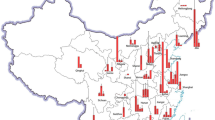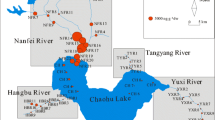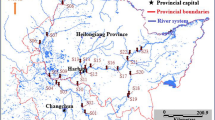Abstract
Purpose
This study investigated the concentrations of cadmium (Cd), chromium (Cr), copper (Cu), lead (Pb), nickel (Ni), zinc (Zn), and polycyclic aromatic hydrocarbons (PAHs) in sediments collected from gully pots for road drainage in Hong Kong. The presence and intensity of anthropogenic contamination of road gully sediments were assessed. Identifications of potential sources of trace elements and PAHs were performed to help understand the situation for future control of pollution to the land and aquatic environments.
Materials and methods
Gully sediment samples were collected from gully pots of 18 roads that are potentially exposed to different pollution sources in Hong Kong. The selection of roads considered different road features, adjacent land uses, and traffic volumes. Composite samples were collected for the analysis of trace elements (Cd, Cr, Cu, Pb, Ni, and Zn) and PAHs by an accredited environmental testing laboratory. Geo-accumulation index (Igeo), contamination factor (Cf), modified degree of contamination (mCd), ecological risk factor (Er), and pollution load index (PLI) were used to assess the level of ecological risk of trace element contamination. Positive matrix factorization (PMF) and PAH diagnostic ratios were applied to identify the sources of trace elements and PAHs.
Results and discussion
Elevated trace element concentrations were commonly found in gully sediments. The concentrations of Zn (267–3700 mg kg−1) were the highest compared to the other trace elements. Noticeable high concentrations of Cu (27–1020 mg kg−1), Pb (21–332 mg kg−1), and Cr (14–439 mg kg−1) were found in all samples. The PAH contents were moderate to high (0.6 to 24.7 mg kg−1). Commercial/industrial emissions and road features that cause frequent acceleration-deceleration and turning events showed important influences on the contaminant levels. Strong correlations between the concentrations of Cd, Cr, Pb, and Zn were identified, implying that these trace elements are likely from common sources. The contamination assessment indices reflect significant sediment pollution. The ecological risk ranges from the considerable/moderate-risk class to over the high-risk class.
Conclusions
The collected gully sediments are identified as highly contaminated and need to be isolated from the environment upon final disposal. Through the comprehensive analysis of the collected data, this study provides a detailed insight into the contaminant levels of road gully sediments and potential sources of contamination. Disposal of gully sediments and potential impacts due to release of contaminants into the downstream aquatic environment during rainstorm events should receive attention and need further investigation.





Similar content being viewed by others
References
Aatmeeyata MS (2010) Polycyclic aromatic hydrocarbons, elemental and organic carbon emissions from tire-wear. Sci Total Environ 408:4563–4568
Addo MA, Darko EO, Gordon C, Nyarko BJB, Gbadago JK (2012) Heavy metal concentrations in road deposited dust at Ketu-South District, Ghana. Int J Sci Technol 2:28–39
Arslan H (2007) Heavy metals in street dust in Bursa, Turkey. J Trace Microprobe Tech 19:439–445
Atiemo SM, Ofosu FG, Aboh IJK, Oppon OC (2012) Levels and sources of heavy metal contamination in road dust in selected major highways of Accra, Ghana. X-Ray Spectrum 41:105–110
Birgul A, Tasdemir Y, Cindoruk SS (2011) Atmospheric wet and dry deposition of polycyclic aromatic hydrocarbons (PAHs) determined using a modified sampler. Atmos Res 101:341–353
Boonyatumanond R, Murakami M, Wattayakorn G, Togo A, Takada H (2007) Sources of polycyclic aromatic hydrocarbons (PAHs) in street dust in a tropical Asian mega-city, Bangkok, Thailand. Sci Total Environ 384:420–432
Chen H, Teng Y, Wang J (2012) Source apportionment of polycyclic aromatic hydrocarbons (PAHs) in surface sediments of the Rizhao coastal area (China) using diagnostic ratios and factor analysis with nonnegative constraints. Sci Total Environ 414:293–300
Depree C (2008) Contaminant characterization and toxicity of road sweepings and catchpit sediments: towards more sustainable reuse options. Land Transport New Zealand Research Report 345. Available via http://www.nzta.govt.nz/assets/resources/research/reports/345/docs/345.pdf. Accessed 21 Feb 2016
Duong TT, Lee BK (2011) Determining contamination level of heavy metals in road dust from busy traffic areas with different characteristics. J Environ Manag 92:554–562
Duzgoren-Aydin NS, Wong CSC, Song ZG, Aydin A, Li XD, You M (2006) Fate of heavy metal contaminants in road dusts and gully sediments in Guangzhou, SE China: a chemical and mineralogical assessment. Hum Ecolog Risk Assess 12:374–389
Dvorska A, Lammel G, Klanova J (2011) Use of diagnostic ratios for studying source apportionment and reactivity of ambient polycyclic aromatic hydrocarbons over Central Europe. Atmos Environ 45:420–427
East-West Gateway Coordinating Council (2000) Highway runoff and water quality impacts. East-West Gateway Coordinating Council. Available via http://www.ewgateway.org/pdffiles/library/aq/wqhwywords.pdf. Accessed 22 June 2017
EL-Bady MSM (2014) Road dust pollution by heavy metals along the sides of expressway between Benha and Cairo, Southern of Nile Delta. Egypt J Appl Environ Biol Sci 4:177–191
Environment Canterbury (2012) Canterbury regional urban stream sediment and biofilm quality survey. Report prepared by Golder Associates (Report No. R12/5). Environment Canterbury. Available via https://www.ecan.govt.nz/data/document-library/?ids=2381830,2433534,2433544,2378551,2360316,1442859,476336,813553,932275,1597829,813561,1083689,1929584,1929055,2993014,927106,785522,1762968,1545732,1151106,2032464,1106929,1258844,1933404. Accessed 16 May 2017
Environmental Protection Department (2013) Water quality. Hong Kong Water Quality Resource Centre. Environmental Protection Department. Available via http://wqrc.epd.gov.hk/en/water-quality/dio_fur.aspx. Accessed 14 November 2015
Environment, Transport and Works Bureau (2002) Technical Circular (Works) No. 34/2002 – Management of Dredged/Excavated Sediment, Hong Kong Special Administrative Region Government
Faiz Y, Tufail M, Javed MT (2009) Road dust pollution of Cd, Cu, Ni, Pb and Zn along Islamabad Expressway, Pakistan. Microchem J 92:186–192
Gadd J, Kennedy P (2000) Preliminary examination of organic compounds present in tyres, brake pads and road bitumen in New Zealand. Report prepared by Kingett Mitchell Ltd for Ministry of Transport. Ministry of Transport. Available via http://www.transport.govt.nz/assets/Import/Documents/stormwater-organics-2.pdf. Accessed 24 May 2016
Ghaleno OR, Sayadi MH, Rezaei MR (2015) Potential ecological risk assessment of heavy metals in sediments of water reservoir case study: Chah Nimeh of Sistan. Proc Int Acad Ecol Environ Sci 5:89–96
Goonetilleke A, Wijesiri B, Brandala ER (2017) Water and soil pollution implications of road traffic. In Hester RE, Harrison RM (ed) Environmental impacts of road vehicles: past, present and future (pp. 86–106). United Kingdom, The Royal Society of Chemistry
Grigoratos T, Martini G (2014) Non-exhaust traffic related emission. Brake and tyre wear PM. JRC Science and Policy Reports (Report EUR 26648EN). Available via https://ec.europa.eu/jrc/en/publication/eur-scientific-and-technical-research-reports/non-exhaust-traffic-related-emissions-brake-and-tyre-wear-pm. Accessed 24 May 2016
Hakanson L (1980) An ecological risk index for aquatic pollution control: a sedimentological approach. Water Res 14:975–1001
Ismail I, Soliman A, Abdel-Monem N, Salah Ahmed H, Sorour MH (2014) Nickel removal from electroplating waste water using stand-alone and electrically assisted ion exchange processes. Int J Environ Sci Technol 11:199–206
Kabata-Pendias A, Pendias H (2001) Trace elements in soils and plants. CRC Press, Washington
Karlsson K, Viklander M (2008) Polycyclic aromatic hydrocarbons (PAH) in water and sediment from gully pots. Water Air Soil Pollut 118:271–282
Kennedy P, Gadd J (2000) Preliminary examination of trace elements in tyres, brake pads and road bitumen in New Zealand. Report prepared by Kingett Mitchell Limited for Ministry of Transport. Ministry of Transport. Available via http://www.transport.govt.nz/assets/Import/Documents/stormwater-inorganic3.pdf. Accessed 26 May 2016
Khairy MA, Barakat AO, Mostafa AR, Wade TL (2011) Multielement determination by flame atomic absorption of road dust samples in Delta Region, Egypt. Microchem J 97:234–242
Li XD, Poon CS, Pui SL (2001) Heavy metal contamination of urban soils and street dusts in Hong Kong. Appl Geochem 16:1361–1368
Likuku AS, Mmolawa KB, Gaboutloeloe GK (2013) Assessment of heavy metal enrichment and degree of contamination around the copper-nickel mine in the Selebi Phikwe Region, Eastern Botswana. Environ Ecol Res 1:32–40
Men C, Liu R, Xu F, Wang Q, Guo L, Shen Z (2018) Pollution characteristics, risk assessment, and apportionment of heavy metals in road dust in Beijing, China. Sci Total Environ 612:138–147
Muller G (1969) Index of geoaccumulation in sediments of the Rhine River. Geo J 2:108–118
Naderizadeh Z, Khademi H, Ayoubi S (2016) Biomonitoring of atmospheric heavy metals pollution using dust deposited on date palm leaves in southwestern Iran. Atmósfera 29:141–155
Nasser MA, Saleh IA (2012) Heavy metal contamination in roadside dust along major roads and correlation with urbanization activities in Cairo. Egypt J Am Sci 8:379–389
Pan H, Lu X, Lei K (2017) A comprehensive analysis of heavy metals in urban road dust of Xi’an, China: contamination, source appointment and spatial distribution. Sci Total Environ 609:1361–1369
Ravindra K, Sokhi R, Van Grieken R (2008) Atmospheric polycyclic aromatic hydrocarbons: source attribution, emission factors and regulation. Atmos Environ 42:2895–2921
Schifman LA, Boving TB (2015) Spatial and seasonal atmospheric PAH deposition patterns and sources in Rhode Island. Atmos Environ 120:253–261
Sivakumar S, Chandrasekaran A, Balaji G, Ravisankar R (2016) Assessment of heavy metal enrichment and the degree of contamination in coastal sediment from south east coast of Tamilnadu, India. J Heavy Met Toxic Dis 1:1
Soltani N, Keshavarzi B, Moore F, Tavakol T, Lahijanzadeh AR, Jaafarzadeh N, Kermani M (2015) Ecological and human health hazards of heavy metals and polycyclic aromatic hydrocarbons (PAHs) in road dust of Isfahan metropolis, Iran. Sci Total Environ 505:712–723
The President and Fellows of Harvard College (2015) WorldMap. The President and Fellows of Harvard College. Available via http://worldmap.harvard.edu/maps/4849. Accessed on 27 July, 2016
Tobiszewski M, Namiesnik J (2012) PAH diagnostic ratios for the identification of pollution emission sources. Environ Pollut 162:110–119
Tomlinson DL, Wilson JG, Harris CR, Jeffrey DW (1980) Problems in the assessment of heavy-metal levels in estuaries and the formation of a pollution index. Helgolander Meeresunters 33:566–575
The Government of the Hong Kong Special Administrative Region (2015a) LCQ6: air pollution caused by container vessels LCQ6 Annex II. Press Releases. Available via http://www.info.gov.hk/gia/general/201506/17/P201506170559.htm
The Government of the Hong Kong Special Administrative Region (2015b) Ocean-going vessels required to switch to clean fuel while at berth with effect from July 1. Press Releases. Available via http://www.info.gov.hk/gia/general/201504/15/P201504150324.htm
Transport Department (2014) The annual traffic census 2014 (TTSD Publication No.15CAB1). Transport Department. Available via http://www.td.gov.hk/en/publications_and_press_releases/publications/free_publications/the_annual_traffic_census_2014/index.html. Accessed 15 Aug 2016
U.S. Environmental Protection Agency Office of Research and Development (2014) EPA positive matrix factorization (PMF) 5.0 fundamentals and user guide (Report No. EPA/600/R-14/108). Washington. Available via https://www.epa.gov/air-research/epa-positive-matrix-factorization-50-fundamentals-and-user-guide
Xia X, Chen X, Liu R, Liu H (2011) Heavy metals in urban soils with various types of land use in Beijing, China. J Hazard Mater 186:2043–2050
Yim WWS, Nau PS (1987) Distribution of lead, zinc, copper and cadmium in dust from selected urban areas of Hong Kong. Hong Kong Eng 7–14
Yisa J (2010) Heavy metals contamination of road-deposited sediments. Am J Appl Sci 7:1231–1236
Zhang W, Zhang S, Wan C, Yue D, Ye Y, Wang X (2008) Source diagnostics of polycyclic aromatic hydrocarbons in urban road runoff, dust rain and canopy throughfall. Environ Pollut 153:594–601
Funding
Support for this project was provided by the Research Grant Council under the Inter-Institutional Development Scheme (IIDS), Ref. No. UGC/IIDS13/E02/14.
Author information
Authors and Affiliations
Corresponding author
Additional information
Responsible editor: Sophie Ayrault
Rights and permissions
About this article
Cite this article
Pun, K.L., Law, S. & Li, G. Trace elements and polycyclic aromatic hydrocarbons in road gully sediments from different land uses, Hong Kong. J Soils Sediments 19, 973–988 (2019). https://doi.org/10.1007/s11368-018-2086-0
Received:
Accepted:
Published:
Issue Date:
DOI: https://doi.org/10.1007/s11368-018-2086-0




